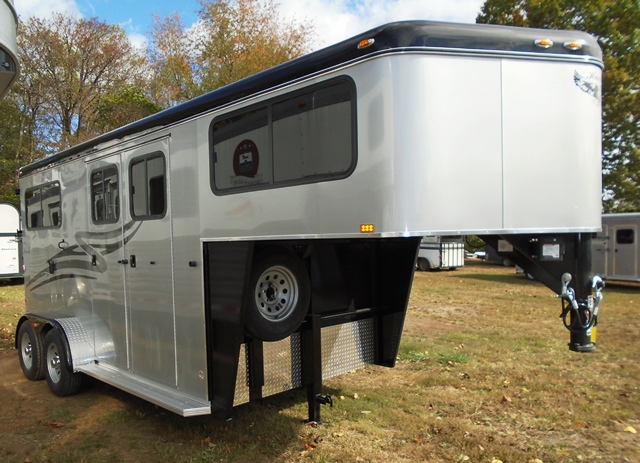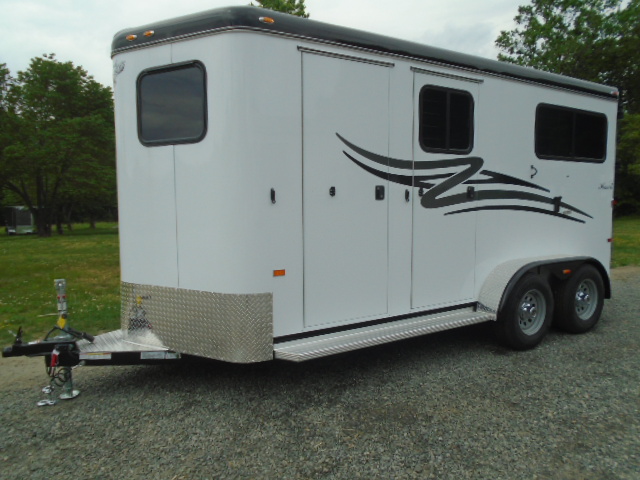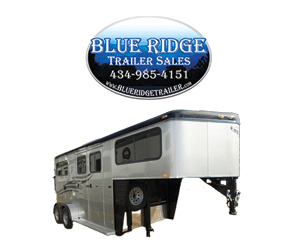Blue Ridge Trailers is a family-owned business, Donna and Rob Martin found their way into the trailer business largely due to Donna’s lifelong relationship with horses. The research she conducted while buying her trailer began the idea of selling them herself. This prompted Blue Ridge to open in January 2002. Donna’s passion for horses, safety, and education is what the Blue Ridge business model is built around.
Our Sales Philosophy
We make sales by educating the customer; we are not comfortable selling the customers something that is not going to meet their needs, so we put a real emphasis on finding out what they need and want. Part of this process can involve helping them sort through which of those wants don’t meet their actual needs.
For example, people don’t necessarily know how big a trailer or what trailer floorplan they need for the safety and comfort of their horses. For example, If they have big horses, they may not only need a bigger trailer and should also avoid a slant load.
Donna and her Sales Team work on understanding a customer’s intended use of trailers, and their horses, so that they can help a customer make the most informed decision. Come see us and we can educate about trailers and to ensure you have the correct truck to pull it with.

Some Things Other Dealers May Not Tell You
Tow Vehicle
◆ Brake Controllers: All horse trailers have brakes, and every tow vehicle must have a brake controller to coordinate the brake pedal with the trailer brakes, through the trailer electric plug. (Some newer model trucks come factory installed- known as an “Integrated Brake Controller”)
◆ Bumper Pull Hitches: Hitches are specific to tow vehicles – year and make – and are generally not interchangeable. Reese/Draw Tite/Hidden Hitch are all made by the same company (CequentTowing Products) and are of exact quality and specifications.
◆ Gooseneck Hitches
— Plate Hitch – permanent ball in the truck bed ($350-500 Installed
— Turnover Ball/Hideaway – ball lays flat in bed when not in use ($1150-$1350 Installed depending on vehicle)
SUV Issues
◆ Wheelbase – the longer the better (Suburban/Yukon XL 2500, Tahoe 1500 – 108”+)
◆ Suspension – Heavy Duty for Towing
◆ Transmission Cooling System for Towing
◆ Brakes – create big problem when towing with smaller SUV (Jeep Grand Cherokee/Ford Explorer)
◆ Weight Distribution Hitches – can increase towing capacity from 3500 lb. to 5000 lb. and 5000 lb. to 7500 lb., 7500 lb. to 10,000 lb. depending on vehicle
◆ Sway Control Bars – can be used with or without a Weight Distribution Hitch
◆ 3500 lb. – 5000 lb. capacity – cannot pull two full-size horses – trailer without dressing room will weigh 2600 lb. – 3200 lb. + 1200 lb. horse = 4400 lb., with dressing room 3200 lb. – 3500 lb. + 1200 lb. horse = 4700 lb.
◆ 6500 lb. – 7500 lb. capacity needed to pull two horses, with or without dressing room. The lower end capacity will probably require a Weight Distribution Hitch.
Truck Issues
◆ 1500 (also known as a ½ ton) – with a towing package (heavy duty suspension and transmission cooling system for towing) may pull up to a 3-Horse Bumper Pull Slant (up to 4200 lb. trailer + 3500 lb. in three horses = 7800 lb. capacity needed)
◆ 2-Horse Bumper Pull w/Dress & Side Ramp (3700 lb. + 2400 lb. in two horses = 6100 lb. capacity needed)
◆ 2500 (also known as a ¾ ton) – must have transmission cooling system and heavy-duty
suspension – may pull up to a 4 horse GN trailer (weight 6700 lb. – 7500 lb. + 4800 lb. in four horses = 12,300 lb. capacity needed). Some newer 2500 (3/4 ton) trucks will pull as much as a 3500 (1 ton) depending on the transmission and cooling system – must check capacities with the manufacturer. Newer models may have up to 15000 lb. towing capacity.
◆ 3500 (also known as a 1 ton) is generally required for more than four horses and should be a Dual Wheel if the trailer is 8’ wide – for balance.

Problem with Newer, Taller Trucks and Older Gooseneck?
Beginning in approximately 2011-2013 (depending on manufacturer), new trucks have been coming out of the factory with the bed/tailgate height taller and taller off the ground. There is no logical explanation or justification for this drastic change in design and specifications.
Example: Our 2003 Dodge 3500 (1 ton) single wheel measured 52 ½” at the highest point of the bed sides and tailgate. Our 2015 Chevrolet 2500 (3/4 ton) measures 58 ½” at the highest point of the bed sides and tailgate. This additional 6” in height, reduces the clearance from the tallest point of the sides & tailgate to the bottom of the gooseneck frame rail on any older gooseneck trailer.
Trailer manufacturers began to rectify this problem by building the gooseneck frame rails further off the ground (approximately 2011-2013 to present), but not universally. If a trailer is leveled correctly (with the front of the empty trailer 2” higher off the ground than the rear of the trailer), there needs to be a minimum of 6” clearance, when the trailer is hooked to and carrying the tongue weight of the trailer, from the highest point of the bed sides & tailgate to the lowest point of the gooseneck frame rail.
The only two ways to make an older gooseneck fit under a newer truck are:
◆ If the trailer has rubber torsion axles (not steel spring axles) then the axles can be removed and up to a 3” piece of channel steel can be welded between the axle box and the top of the reattached axles (Cost $600-$800 depending on how the torsion axles are attached to the trailer). This will gain up to 3” of clearance, safely, while maintaining correct balance. The negative is that this additional trailer height, off the ground, will make a step-up higher for loading and unloading or it will make a ramp steeper off the ground.
◆ Removing the bed of the truck and replacing it with a flat bed, will negate this clearance issue entirely. The negative is that the utilitarian features of truck bed sides is lost.
Extending an adjustable gooseneck coupler will not solve this problem. Adjusting the coupler to make it longer will increase the clearance distance between the top of the bed/tail gate and the gooseneck frame, however, it will cause the trailer to no longer be level. When the coupler is extended, the front of the trailer will be significantly higher off the ground than the rear of the trailer, putting dangerous excess weight on the rear axles and tires. This can cause tires to blow out and/or rear axles to bend (a blow out, especially when a trailer is loaded with livestock is terrifying and exceedingly dangerous). Often fenders are also destroyed during a tire blow out. Replacing a bent axle can cost between $600- $1200, not counting replacing any tires that may have been damaged by running on a bent axle.

Trailer Height and Width Make a Difference
Horses are claustrophobic by nature so the bigger the trailer, the better it is for the horse. Most trailers are built 6’ wide or 6’8” to 7’ wide and 7’ tall or 7’6 to 7’8” tall.
You need to make sure you get the size trailer for your Pony or Horse. They are a few things you must take into consideration.
1. Ponies and horses up to 15.2 hands will be okay in a 7’ tall trailer.
2. Anything above that you should have in a 7’6 + tall trailer.
3. The width depends. If you have a narrow horse, then 6’ wide is okay, but if you are a fox hunter and like to travel with the saddle on, you will need a 6’8 wide.
Gooseneck or Bumper Pull Trainer?
Trailer shopping requires many decisions. The most important decision to make when purchasing a trailer is the type of trailer – gooseneck or bumper pull. Each type of trailer has pros and cons. You will be able to use this information to decide which type of trailer is right for you.
Bumper Pull Trailers
The most common type of hitch is the bumper pull hitch. This name is slightly misleading because the hitch is not actually connected to the bumper. A bumper pull connects to a ball hitch that comes out from the vehicles frame. Because this type of hitch is so common, this type of trailer is ideal for a first-time trailer owner. Many first-time trailer owners really appreciate that a bumper pull has a normal turn radius, meaning the trailer follows the towing vehicle as it makes a turn.
Bumper pull trailers are smaller than gooseneck trailers which means they are usually more affordable. Many vehicles can pull a bumper pull trailer, so you are not necessarily restricted to a pickup truck. Larger SUVs with a long wheelbase and a low center of gravity are the safest tow vehicles for these trailers.
Bumper pull trailers are smaller, so you are limited on space for living quarters, dressing room, and number of animals that can be hauled. Not only can space be an issue, but weight can be as well. These trailers have weight restrictions so you need to know what you will be hauling and what your vehicle is capable of towing as well.
Gooseneck Trailers
Gooseneck trailers are much different than bumper pulls. A gooseneck trailer attaches to a ball hitch that is in the bed of a pickup. The trailer’s tongue weight is over the truck’s rear axle when hitched up, rather than that of a bumper pull which is at the back of the frame. This reduces the amount of sway and vibration, especially if the trailer hits a bump or pothole in the road.
Because gooseneck trailers offer more stability, they can handle much more weight than a bumper pull. This allows gooseneck trailers to have more space for living quarters, animals, etc. A gooseneck trailer also has a tighter turn radius. This lets the driver cut corners tighter than you could with a bumper pull making it significantly more maneuverable in tight spaces.
Because goosenecks are larger, they are generally more expensive than a bumper pull. Not only are the trailers themselves more, but a larger truck is required to haul the trailer. Most trucks do not come equipped with a gooseneck hitch. Blue Ridge can install a gooseneck hitch for you if you decide a gooseneck trailer is best for you and your horse.
As you can tell, both types of trailers have pros and cons depending on what you need. Choose the trailer that is right for you based on what you are hauling. You want the best ride to optimize your trailering experience. If you are not 100% sure what type of trailer would be best suited for you, your horse and your hauling vehicle, our staff would be honored to talk with you. Contact us today!
Do You Need Insurance for Your Trailer?
Having the right trailer insurance is important not only when a crisis strikes, but also for your peace of mind while traveling with your four-legged best friend and/or expensive equipment.
Yet many people drive for years with inadequate coverage, only discovering the holes in their insurance plan when it’s too late. Of course, every situation is different depending on your trailer, horse and/or livestock, other cargo/equipment and travel needs. That’s why it’s so important to communicate with your insurance agent so you know you have the right coverage for your circumstances.
Here are some key questions to ask your agent regarding horse trailer insurance:
1. Do I have comprehensive/collision coverage?
One of the biggest misconceptions we see among trailer owners: they know their tow vehicle insurance extends to their trailer, but don’t realize that the insurance only covers liability—not damage or theft.
In other words, they’re covered for costs involving damage to someone else’s property or injuries caused by their trailer. But they’re not covered for the cost of damage to their trailer and trailer contents in an accident, storm or other crisis.
To protect your trailer, you’ll want to ask your insurance agent about comprehensive and collision coverage. This can protect your trailer in cases of damage, theft, vandalism, and more.
Most vehicle insurance companies will simply add an endorsement to your existing policy, which extends comprehensive and collision coverage to your trailer. This is typically a minor expense per year. If your insurer requires a separate policy for the trailer—rather than merely adding a trailer endorsement—then you should shop around (In this situation, Virginia residents should consider pricing a policy with their local Farm Bureau agent. Farm Bureau offers several different coverage’s that you might want to consider.) Adding a standalone policy can be very expensive- so shopping might very well pay off.
2. Are the contents of my trailer covered?
You don’t just want to protect your trailer, but also your property inside it. Ask your insurance agent whether your trailer contents would be covered in cases of damage or theft. Your Homeowner’s policy might cover trailer contents, rather than your vehicle policy (even though you have obtained comprehensive and collision for your trailer) in the case of accident or theft, ask your agent.
Be aware that “trailer contents” refers to equipment and gear, not your horse itself. You may want to consider a policy to cover your horse(s). The major national companies offering equine insurance are Taylor Harris, EMO, Marshall & Sterling and Markel. There may also be coverage available in your area from a more local company.
3. What will happen if I have a breakdown with my horse in the trailer?
Here’s something I learned the hard way. Some insurance companies (and roadside assistance companies like AAA) will tow your vehicle if you have a breakdown but won’t extend roadside service to your trailer.
It is incredibly stressful to have a horse in a trailer on the side of the highway, under the sun, and no way to get it moved off the highway and to a safe place. Ask your insurance agent and/or roadside assistance company whether your trailer and horse(s) will be covered for breakdown services, and if not, you might consider looking into another policy with a company that offers national roadside equine services.
4. Is my trailer covered when it’s parked?
It’s easy to forget that trailer problems don’t just happen on the road. Ask your insurance agent how you’re covered in the case of storm damage, fire, and theft when your trailer is parked. If you store your trailer on someone else’s property or farm, you’ll also want to know how that impacts your coverage.




